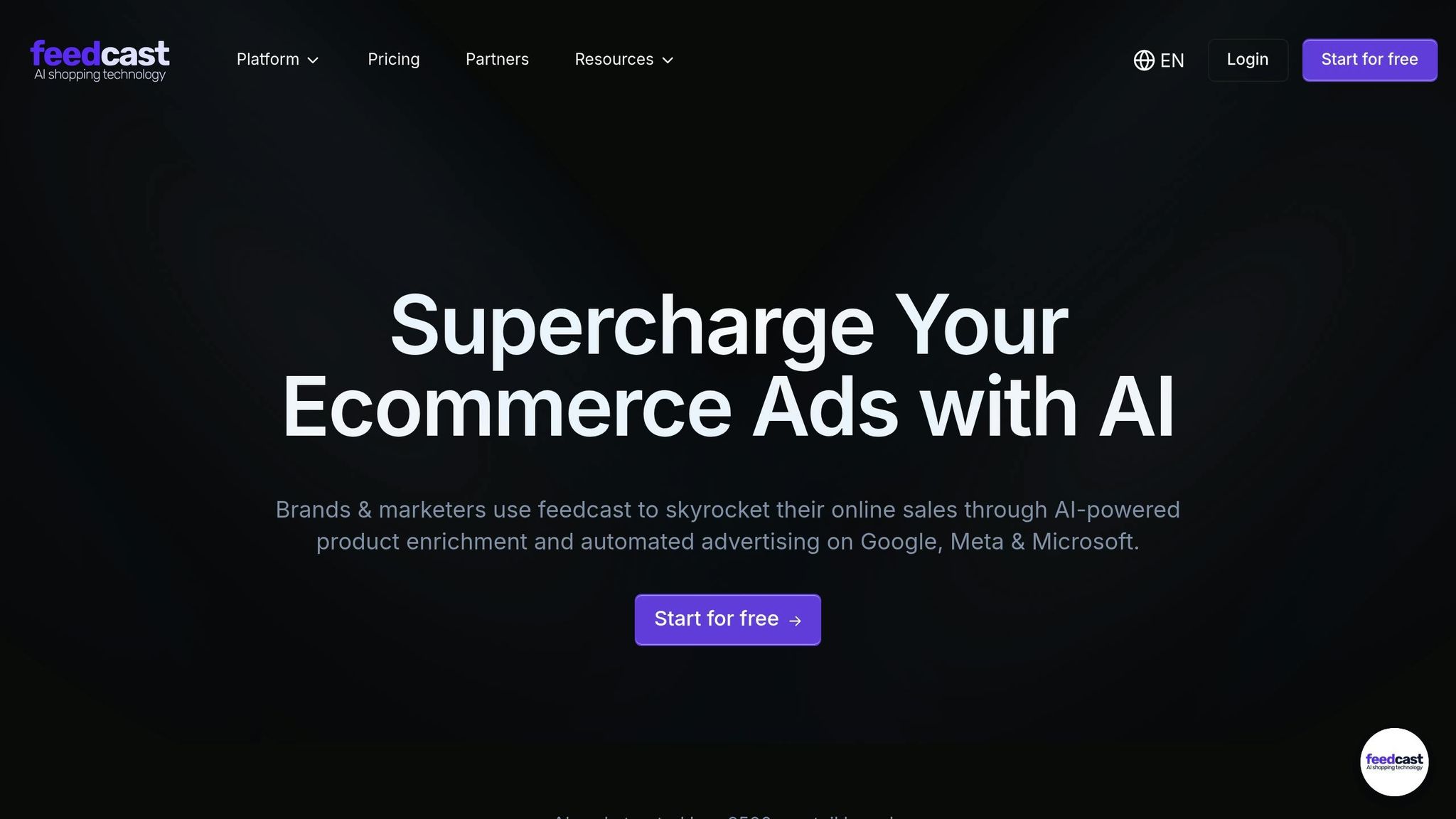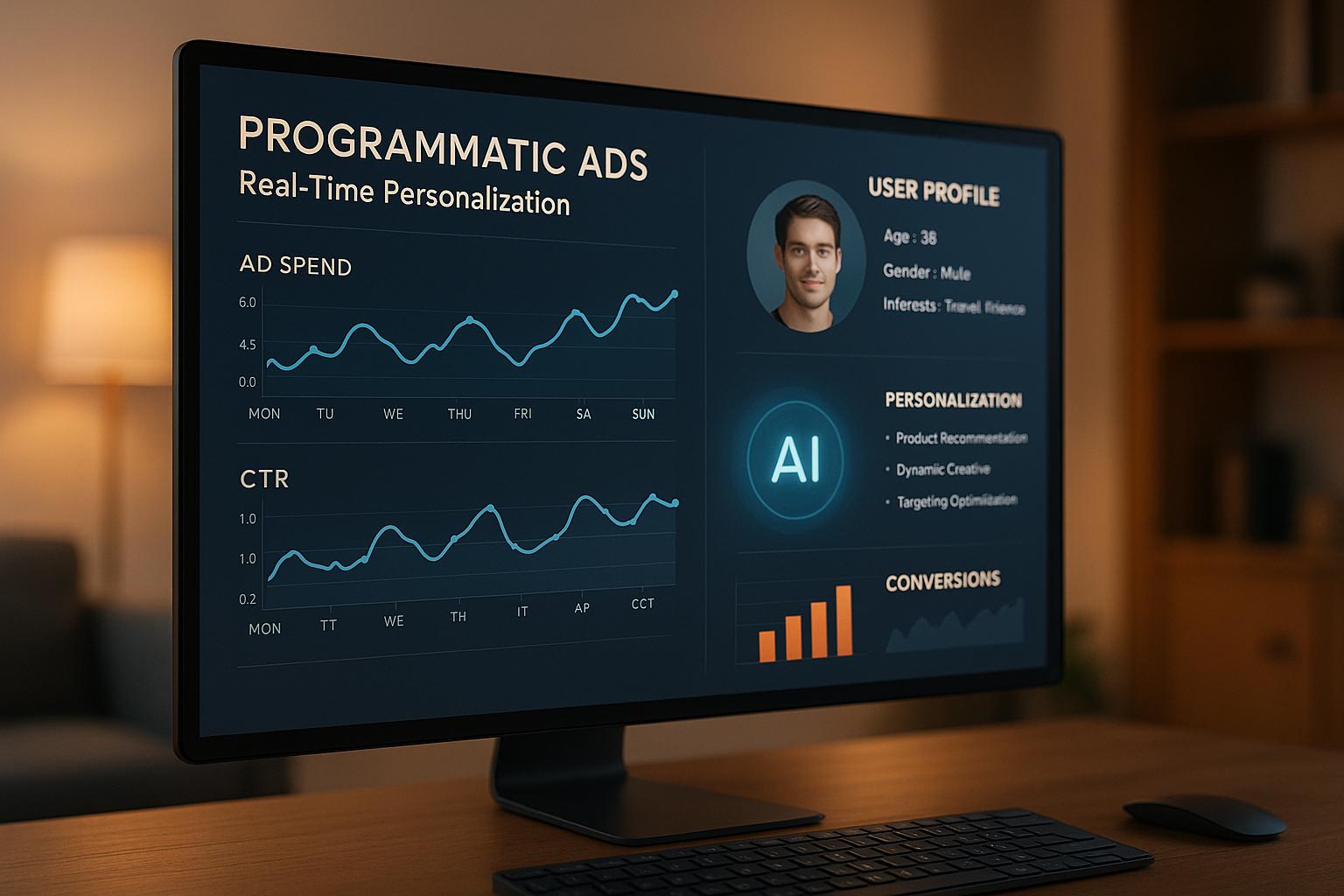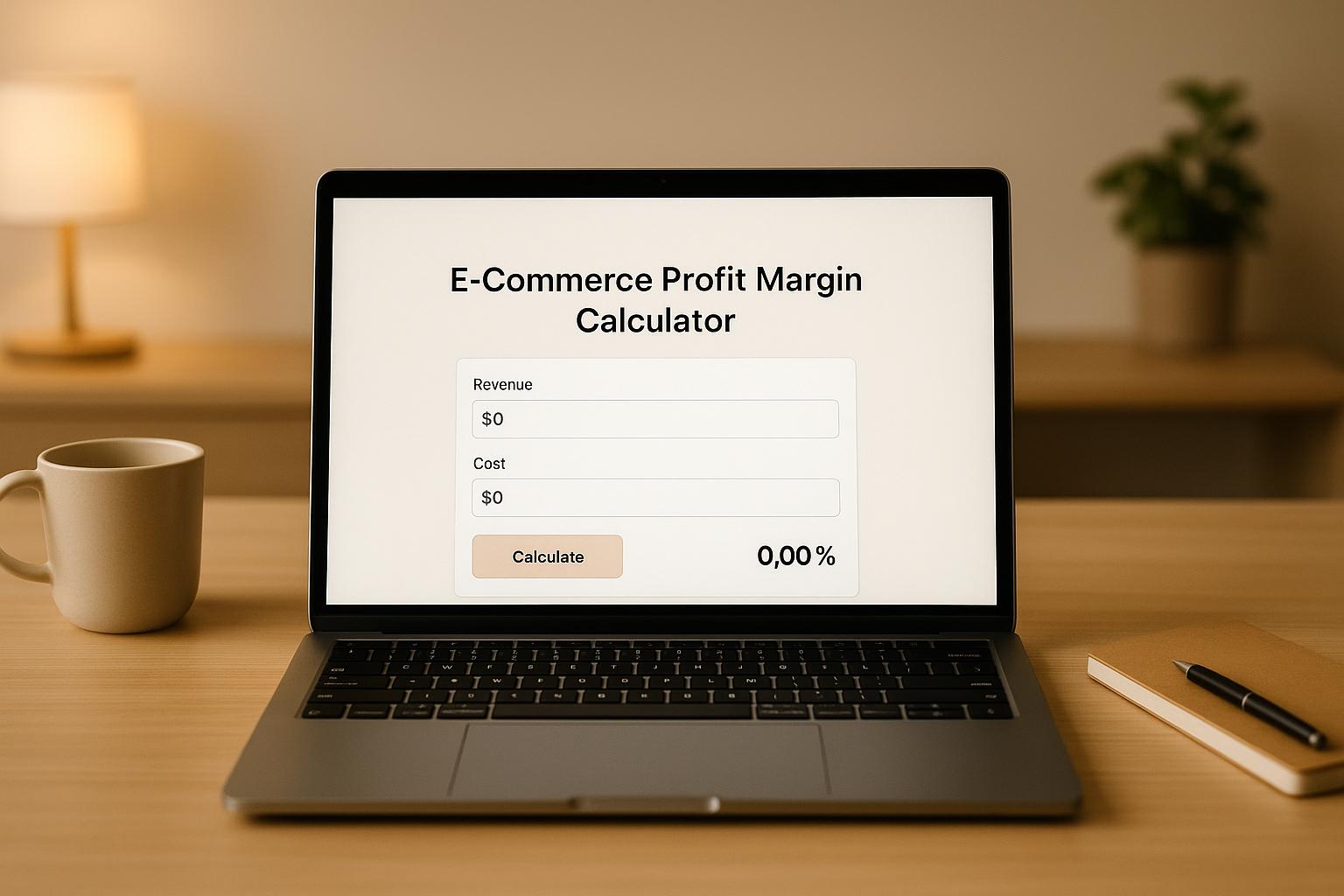How AI Improves Product Titles for Google Ads
AI is transforming how businesses optimize product titles for Google Ads, making them more effective and efficient. Here's why it matters and how AI simplifies the process:
- Why Product Titles Are Key: Titles are the second most important factor (after images) for ad visibility and clicks. Well-optimized titles can boost click-through rates (CTR) by up to 88% and conversions by 94%.
- How AI Helps: AI analyzes search trends, competitor data, and user behavior to craft titles that match shopper intent. It automates tasks, ensures consistency, and updates titles in real-time to align with market trends.
- Common Mistakes AI Solves: Issues like keyword stuffing, vague descriptions, or exceeding character limits are resolved with AI, improving ad performance.
- Scalability: AI can handle thousands of product titles, saving time and reducing errors, especially for businesses with large catalogs.
- Results: Businesses using AI for title optimization report significant improvements in clicks, conversions, and ad efficiency.
AI-powered tools, like Feedcast.ai, streamline the process by offering automated title recommendations, error detection, and multi-channel optimization. Whether you're managing a small or large product catalog, AI ensures your titles are clear, effective, and aligned with Google’s guidelines.
I Got AI To Optimize Google Shopping In 10 Minutes [Free AI Tool Included]
What Makes Product Titles Work in Google Ads
Creating effective product titles is all about matching shopper intent with relevant searches. A well-crafted title not only grabs attention but also ensures your ads appear for the right queries. Getting this right is crucial, especially when incorporating AI tools into your strategy. Here's a breakdown of what makes product titles successful and the common missteps to avoid.
Key Elements of Good Product Titles
The best product titles put the most critical details front and center. Since Google focuses on the first 70 characters to determine ad relevance [4], it's essential to prioritize key information upfront. A strong title typically includes:
- Brand name
- Product type
- Key features (like size, color, material)
- Model numbers
- Unique attributes
Google emphasizes the importance of clarity in titles, stating:
"A specific and accurate title will help us show your product to the right customers."
– Google Merchant Center Help [4]
For established brands, placing the brand name at the beginning of the title can build trust and increase click-through rates. On the other hand, newer brands might find it more effective to lead with the product type to capture attention.
Descriptive details like color, size, and material help Google match your ad to relevant searches. For example, research shows that 97% of product titles use digits instead of spelling out numbers, and 70% rely on symbols to separate attributes [5]. Structuring titles to mirror how shoppers search can make a big impact. For instance:
- Fashion items: "Brand + Gender + Product Type + Color + Size"
- Electronics: "Brand + Product Type + Model + Key Feature"
Real-world examples back this up. Zoobgear, a sports equipment retailer, used keyword research to refine their product titles and include more relevant details. The result? A 250% increase in clicks [1]. While these strategies can drive success, avoiding common mistakes is just as important.
Product Title Mistakes to Avoid
Even small errors in product titles can hurt ad performance and waste your ad budget. Here are some pitfalls to watch out for:
Keyword stuffing: Overloading titles with keywords might seem like a good idea, but it can make them cluttered and trigger Google’s quality filters. Keep titles clear and concise instead.
Vague descriptions: Titles like "Great Product" or "Best Quality Item" fail to provide meaningful details, making it harder for Google to match your ad to relevant searches. This often results in poor targeting and wasted clicks [5].
Inconsistent titles: Data reveals that 81% of product titles in feeds differ from those on product pages, which can confuse both Google and potential customers [5].
Ignoring character limits: Titles longer than 70 characters risk being cut off, hiding important details [1]. Surprisingly, 74.18% of titles don’t fully utilize the available space to include extra valuable information.
Poor prioritization: When less important details are placed at the beginning of the title, critical information like the brand or product type gets buried, reducing relevance for high-intent searches.
Take Searchmind as an example. They tackled these issues by replacing generic terms with specific, descriptive language and optimizing their product feeds. This approach led to a 38% increase in click-through rates, a 9.32% drop in bounce rates, and a 94% boost in conversions year-over-year [1].
How AI Makes Product Titles Better
AI has revolutionized how product titles are optimized by diving deep into performance data to pinpoint the elements that drive clicks and conversions. This builds on the earlier discussion about the importance of crafting precise and effective titles.
AI Features That Improve Titles
AI does more than just sprinkle in keywords - it takes a smarter approach to refining product titles. By analyzing existing product data, it identifies missing details and areas for improvement, then restructures titles to make them as impactful as possible.
At its core, AI-powered title optimization relies on two key pillars: keyword integration and performance analysis. AI tools dig into search query reports to find the terms shoppers actually use, naturally weaving these keywords into titles without clunky or forced phrasing. The result? Titles that not only rank well but also resonate with potential buyers. For example, AI-driven tweaks have been shown to significantly increase click-through rates and conversions[1].
Another standout feature is real-time performance optimization. AI constantly monitors ad performance, identifying which titles perform best and using those insights to improve weaker listings. It can even automatically add missing GTINs (Global Trade Item Numbers) to product feeds, a step that has been linked to a 20% average boost in clicks for Shopping ads and listings[3]. Plus, AI ensures titles follow Google's best practices, such as placing the most critical information within the first 50–70 characters.
Using AI to Analyze Search Trends and Competitors
AI takes title optimization a step further by leveraging its ability to process vast amounts of market data - something humans simply can’t do efficiently. It tracks search trends, seasonal shifts, and competitor strategies to recommend title updates that align with current market dynamics.
By keeping tabs on market trends, AI identifies emerging search terms and seasonal preferences, enabling timely updates that keep listings relevant. For example, if a certain color or feature becomes trendy, AI ensures your titles reflect that change quickly.
Competitor analysis is another area where AI shines. It studies successful competitor titles to uncover effective keyword combinations and structural patterns. But it doesn’t just copy - AI adapts these insights to fit your products and brand voice. A great example of this is how Socium used AI-driven testing to optimize the placement of brand names in titles, achieving a 25% increase in return on ad spend and cutting cost-per-click by 10%[2].
This level of intelligence becomes even more powerful when applied to large inventories, as explored below.
Scale and Automation Benefits
One of AI’s biggest strengths is its ability to handle scale. While manually optimizing a handful of titles is manageable, doing the same for thousands - or even millions - of listings is a different story. AI makes it possible.
Automated title generation and updates eliminate the time-consuming task of manual product management. AI can analyze product images, extract key details, and create accurate titles that include essential attributes like brand names, product types, colors, and sizes. This ensures consistency across your catalog while staying true to your brand's tone and style.
The impact of this scale is huge. Rob Gonzalez, co-founder of Salsify, highlights the shift AI brings:
"What AI will allow you to do is have a perfect product detail page with every bullet SEO optimized, with every image set up for conversation, with all of the manufacturer stuff filled out - on every single page where your products can show up."[7]
AI also simplifies the process of maintaining consistent, optimized titles across platforms like Google Ads. It analyzes your existing content and mirrors your brand's tone, style, and messaging, ensuring every title meets your standards while being search-friendly.
For retailers managing large catalogs, the potential savings are staggering - up to $340 billion annually, thanks to improved efficiency and performance[8]. AI also addresses a major e-commerce pain point: 54% of shoppers abandon purchases due to incomplete or poorly written product titles or descriptions[7]. By ensuring every product title is complete and optimized, AI directly reduces abandonment rates while improving the shopping experience.
Finally, automation frees your team from repetitive tasks, allowing them to focus on strategy. As Gonzalez puts it:
"It's going to be an amplifier - especially for those longtail products. And it's going to make every single person on your team that's responsible for the digital shelf more productive."[7]
sbb-itb-0bd1697
Step-by-Step Guide to AI Product Title Optimization
Ready to put AI-driven title optimization into action? Here's a practical guide to help you turn insights into results.
Step 1: Upload Product Data and Identify Problem Titles
Start by uploading your product data into an AI-powered platform. These tools can quickly scan your entire catalog and pinpoint issues that would otherwise take hours to uncover. The AI will flag problems like policy violations, restricted terms, missing attributes (such as GTINs, MPNs, or brand names), pricing inconsistencies, and even image resolution errors.
For instance, in April 2025, Bryan Falla from godatafeed.com showcased how ChatGPT could identify problematic titles. He used the example of a product titled "CBD Oil for Relaxation", which violates Google’s Dangerous Products policy. A simple prompt like, "Identify instances of 'CBD oil' in this product feed and suggest compliant alternatives that align with Google Merchant Center policies," can help resolve such issues swiftly[9].
By automating this process, you can efficiently detect and prioritize errors, focusing on the most critical fixes first[10].
Step 2: Apply AI Suggestions to Optimize Titles
Once issues are identified, leverage AI-generated recommendations to enhance your product titles. This step is all about refining titles by adding relevant keywords, improving their structure, and ensuring they comply with Google’s guidelines.
AI tools analyze your data and suggest optimized titles that incorporate high-performing keywords while adhering to technical and policy requirements. They can even match your products to the correct Google Product Categories, boosting their visibility in search results.
When implementing these AI-generated titles, ensure they use the proper structured attributes for compliance. To validate their effectiveness, run A/B tests comparing the new titles against your current ones. This will help you identify which changes yield better results. After applying the updates, track performance metrics to assess the impact of these optimizations.
Step 3: Monitor Results and Refine Strategies
Tracking performance is essential to measure success and uncover opportunities for further improvement. Once your AI-optimized titles are live, keep a close eye on key metrics in Google Merchant Center, such as impressions, clicks, CTR, and purchases. These insights will reveal trends in how your products are performing.
The Search Terms report in Google Ads is another valuable resource. It highlights the specific keywords driving traffic and sales, helping you refine your titles even further[12]. If certain AI-suggested keywords underperform, adjust them accordingly.
To gauge profitability, calculate your return on investment (ROI) using the formula: (Revenue - Cost of goods sold) / Cost of goods sold[13]. This will confirm whether your optimized titles are not just attracting clicks but also increasing profits.
Keep in mind that it may take a few days for impressions to reflect your changes, so give it some time[11]. Focus on high-demand products, such as those labeled "popular-now" or "trending up", and ensure they remain in stock to maximize the impact of your efforts[11].
Feedcast.ai: AI-Powered Product Title Optimization Made Simple

Feedcast.ai makes optimizing product titles for e-commerce a breeze by leveraging AI to simplify what can often be a tedious process. By blending AI-driven data refinement with multi-channel advertising management, the platform takes the guesswork out of improving Google Ads campaigns. It’s all about making feed management and data enhancement straightforward and efficient.
AI Product Data Enhancement Features
Feedcast.ai’s AI takes charge of analyzing and improving your product titles, descriptions, and attributes to elevate ad performance across various advertising platforms. Its advanced algorithms craft better titles by integrating relevant keywords while staying compliant with Google’s policies.
But it doesn't stop at keywords. Feedcast.ai’s system digs deeper, pulling out critical product details like color or size and assigning them to the correct attributes. This ensures your products show up in the right searches, eliminating the need to manually sift through and edit thousands of titles.
Once your product data is uploaded, the AI immediately gets to work. It evaluates each title to find opportunities for improvement, offering suggestions that include high-performing keywords, precise product details, and structured formats favored by Google’s algorithms. Importantly, the optimized titles maintain your brand’s tone while enhancing visibility in search results.
Unified Dashboard and Automation Tools
Feedcast.ai’s centralized dashboard makes multi-channel title optimization effortless. Products can be imported directly from leading e-commerce platforms or common file types, streamlining the setup process.
This all-in-one approach allows you to optimize titles once and distribute them across platforms like Google, Facebook, Instagram, Microsoft Ads, and more. Each channel receives titles tailored to its unique audience and requirements, ensuring maximum relevance.
The platform also automates technical tasks, such as detecting and resolving feed errors. For example, if Google Merchant Center flags issues with your titles, Feedcast.ai identifies the problem and suggests fixes automatically. This significantly cuts down on the time spent troubleshooting, allowing for smooth deployment across all channels.
| Platform | Key Optimization Focus |
|---|---|
| Google Shopping | Clear, descriptive titles aligned with search intent |
| Facebook/Instagram | Attributes customized for specific demographic groups |
| Detailed tagging paired with high-quality visuals | |
| TikTok | Trend-based product videos |
Google Ads Campaign Benefits
Feedcast.ai seamlessly integrates with Google Ads, directly enhancing campaign performance. As a certified Google CSS (Comparison Shopping Service) partner, it offers perks like cost savings and improved visibility for your products in Google Shopping results, going beyond standard title optimization.
The platform’s real-time analytics dashboard gives you a clear view of how your optimized titles are performing within Google Ads. Metrics such as click-through rates, impressions, and conversions are tracked so you can see the tangible impact of AI-driven improvements. This data empowers you to identify which strategies deliver the highest return on investment.
For those looking to experiment or scale, Feedcast.ai offers unlimited AI credits with its Premium plan ($249/month). This allows continuous testing and refinement of titles for sustained performance gains. And for businesses new to AI-driven optimization, the free plan provides a great starting point. It includes platform access, ad account linking, and the ability to advertise up to 1,000 products on free channels - perfect for testing the waters before upgrading.
Feedcast.ai’s tracking capabilities go beyond surface-level metrics. With detailed attribution analysis, you can use valuetrack parameters to pinpoint how specific title changes impact campaign performance. This granular insight helps you understand which optimizations drive the most valuable traffic and conversions.
Conclusion: AI Product Title Optimization Results
The numbers are in, and they show that using AI for title optimization can greatly improve the performance of Google Ads campaigns. Across various industries and business sizes, case studies have demonstrated noticeable gains in click-through rates (CTR), conversions, and overall campaign effectiveness.
The evidence is clear: well-crafted titles lead to higher engagement and better results. For instance, keyword-rich product titles have been shown to increase CTR by 18%, while matching product titles exactly to search queries can drive an impressive 88% boost in CTR [1]. Additionally, Google has found that providing accurate GTINs can result in a 20% average increase in clicks for Shopping ads and product listings [3].
AI-driven optimization doesn’t just deliver short-term wins - it adapts to changing markets, seasonal trends, and evolving search behaviors. For example, renaming a product from "cotton short-sleeve top" to "cotton T-shirt" led to a 15% increase in clicks [6]. These continuous, automated adjustments ensure businesses stay ahead of the curve.
Tools like Feedcast take these benefits further by scaling title optimization across thousands of products. They ensure brand consistency and compliance with Google’s policies, all while reducing manual effort. With average conversion rates of 3.5% for product pages and 7% for add-to-cart actions [14], even small improvements in title performance can lead to significant revenue growth.
In today’s competitive e-commerce environment, AI-powered title optimization isn’t just helpful - it’s essential. By leveraging these automated solutions, businesses can enhance their Google Ads campaigns and set themselves up for long-term success.
FAQs
How does AI optimize product titles to match shopper intent and market trends?
AI refines product titles by studying search trends, customer behavior, and top-performing keywords. Using real-time data and generative AI, it creates titles that match current market trends and reflect what shoppers are actively searching for.
This method makes product titles both descriptive and appealing, boosting visibility and click-through rates in campaigns such as Google Ads.
What common mistakes do businesses make with product titles, and how can AI help fix them?
When it comes to product listings, businesses sometimes stumble with keyword stuffing, generic or duplicate titles, neglecting keyword research, or failing to craft titles that are truly descriptive and engaging. These missteps can make products harder to find and less appealing to potential customers, ultimately hurting ad performance.
AI offers a solution by analyzing product data and creating titles that are clear, relevant, and aligned with what users are searching for. It ensures keywords are included naturally, enhances readability, and adjusts titles to meet the best practices of specific platforms, like Google Ads, boosting visibility and relevance.
How does AI help streamline managing large product catalogs for Google Ads?
AI takes the hassle out of managing extensive product catalogs on Google Ads by handling tasks like updating product feeds and spotting errors automatically. This not only cuts down on manual effort but also ensures your campaigns remain accurate and current.
On top of that, AI allows for real-time adjustments, letting you tweak campaigns on the fly to boost performance and scale effectively. By streamlining these processes, businesses can shift their focus to strategic planning and growth rather than getting bogged down by tedious data tasks.
Geoffrey G.




